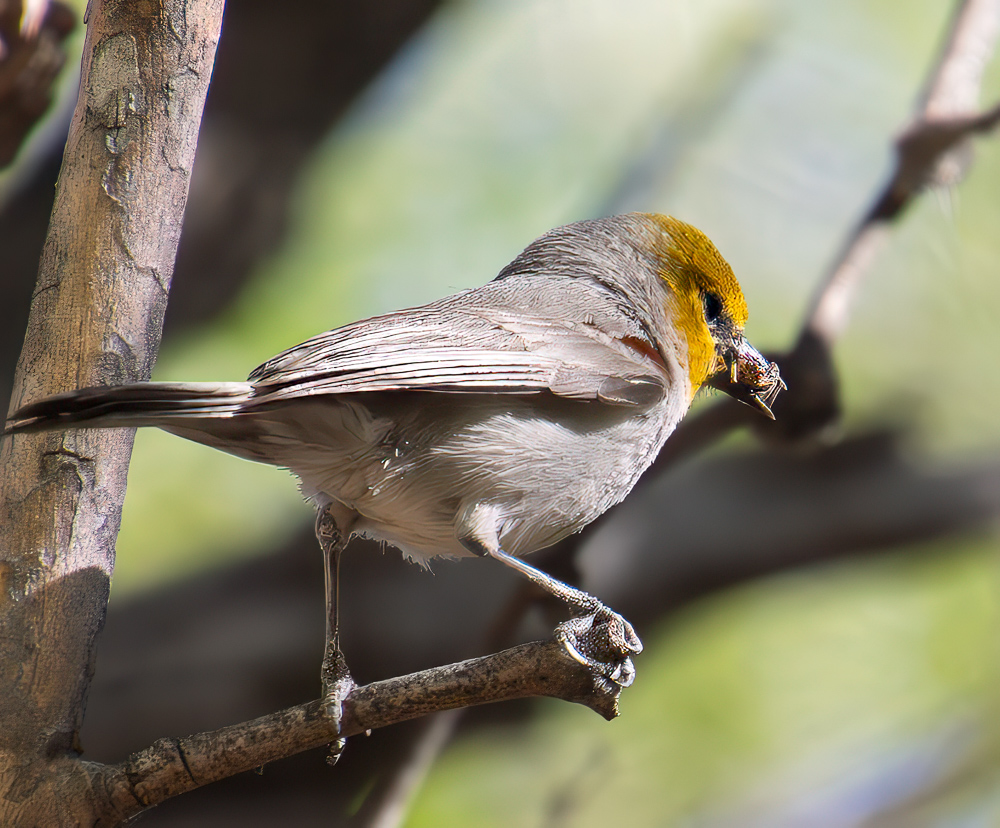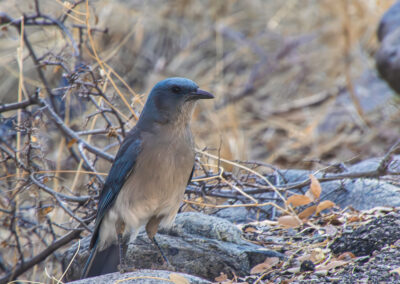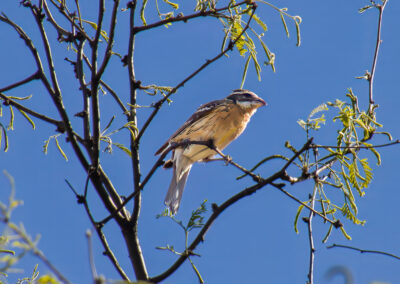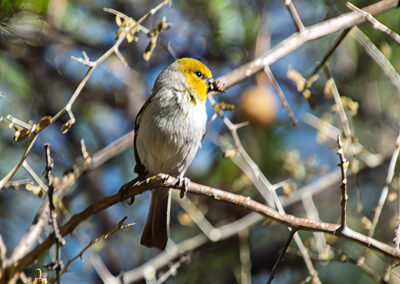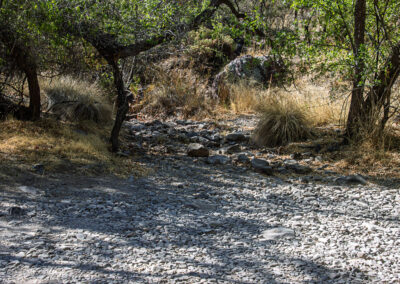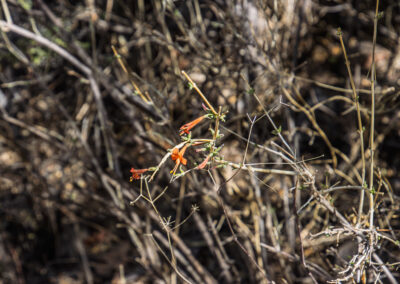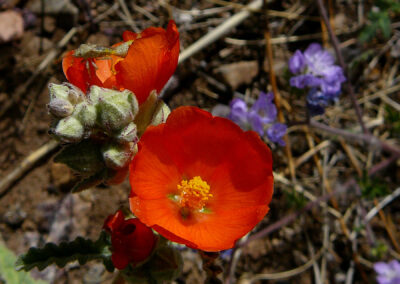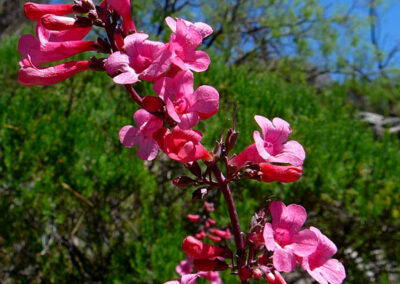September Monsoon 2025
By Doug Moore
Despite a fitful start, the 2025 summer monsoon brought better precipitation, particularly greening up the lower canyon and mitigating to at least some extent the historic drought period that lasted from November 2024 to June 2025.
An FoMC nature walk around the Proctor Loop Trail on Saturday, September 13, found the creek still dry, but trailside shrubs and trees were in full leaf and the many late sprouted annuals short of stature, but blooming with summer flowers, particularly morning glories, day flowers, and several daisy species.
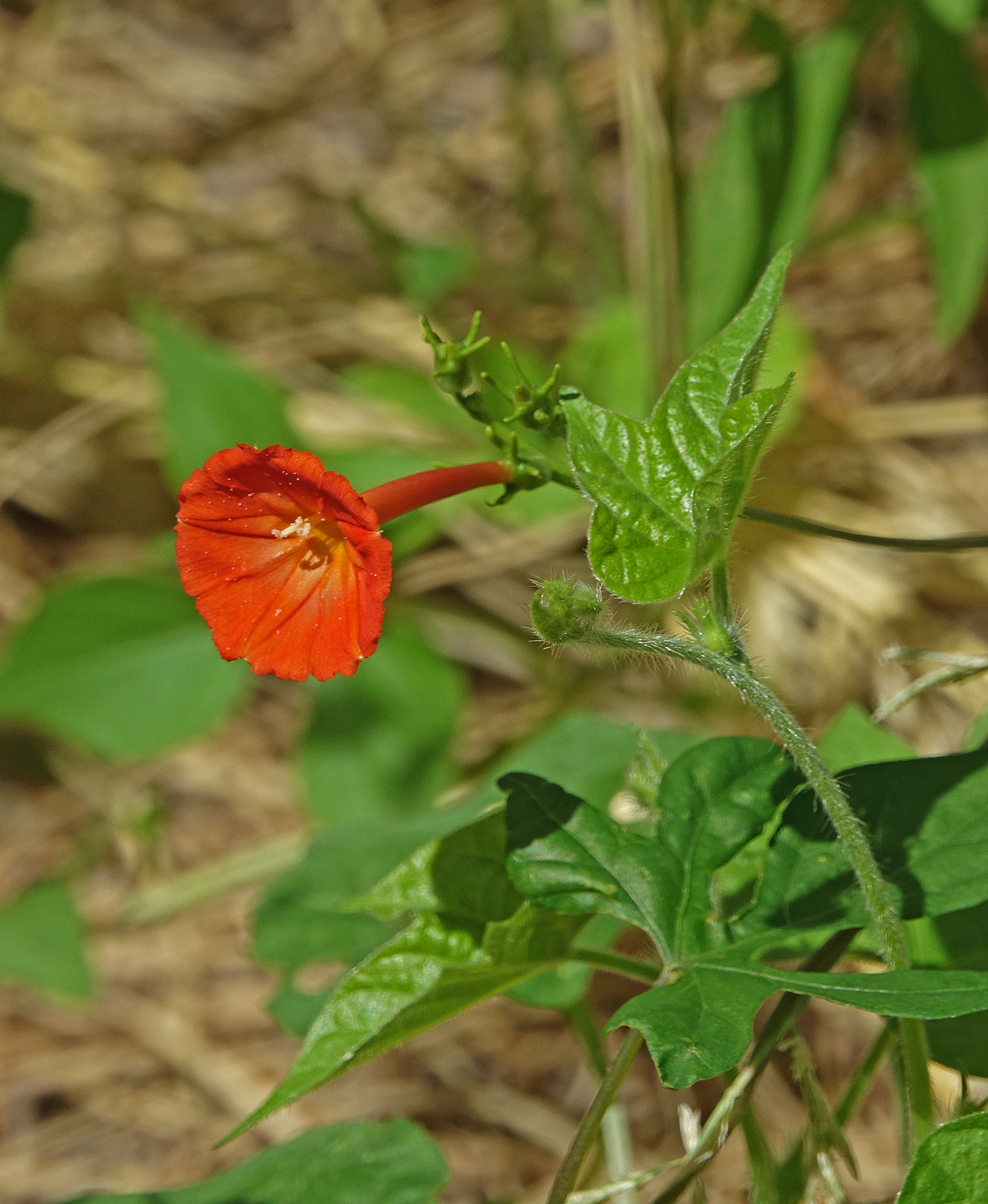
Scarlet Creeper morning glory
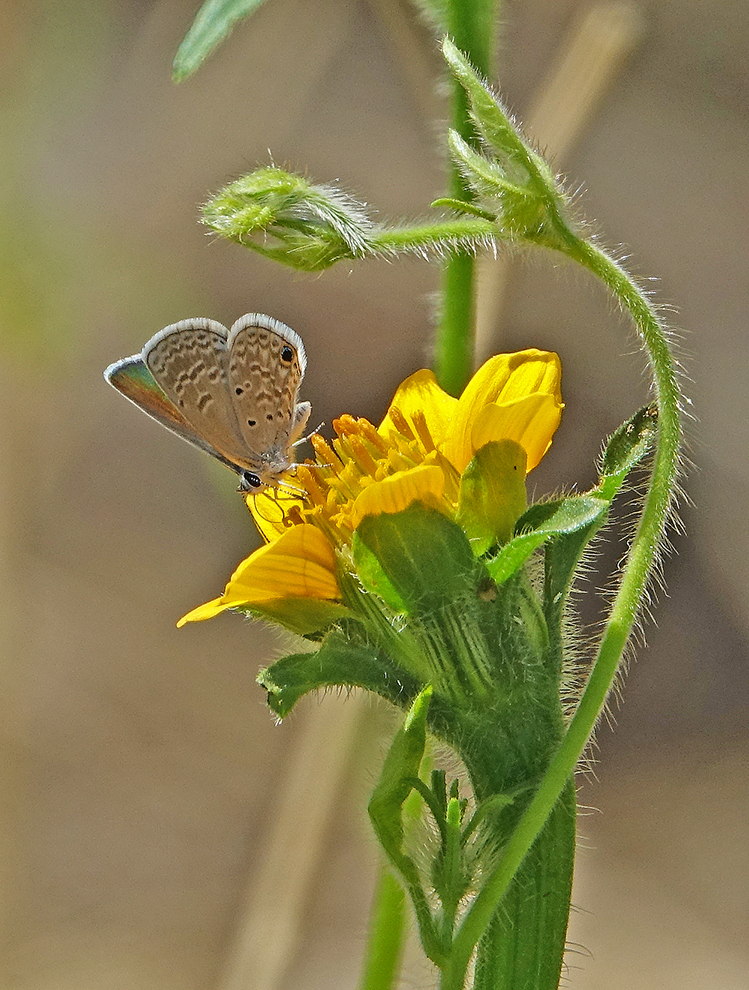
Ceraunus Blue Butterfly on Thurber’s Tithonia
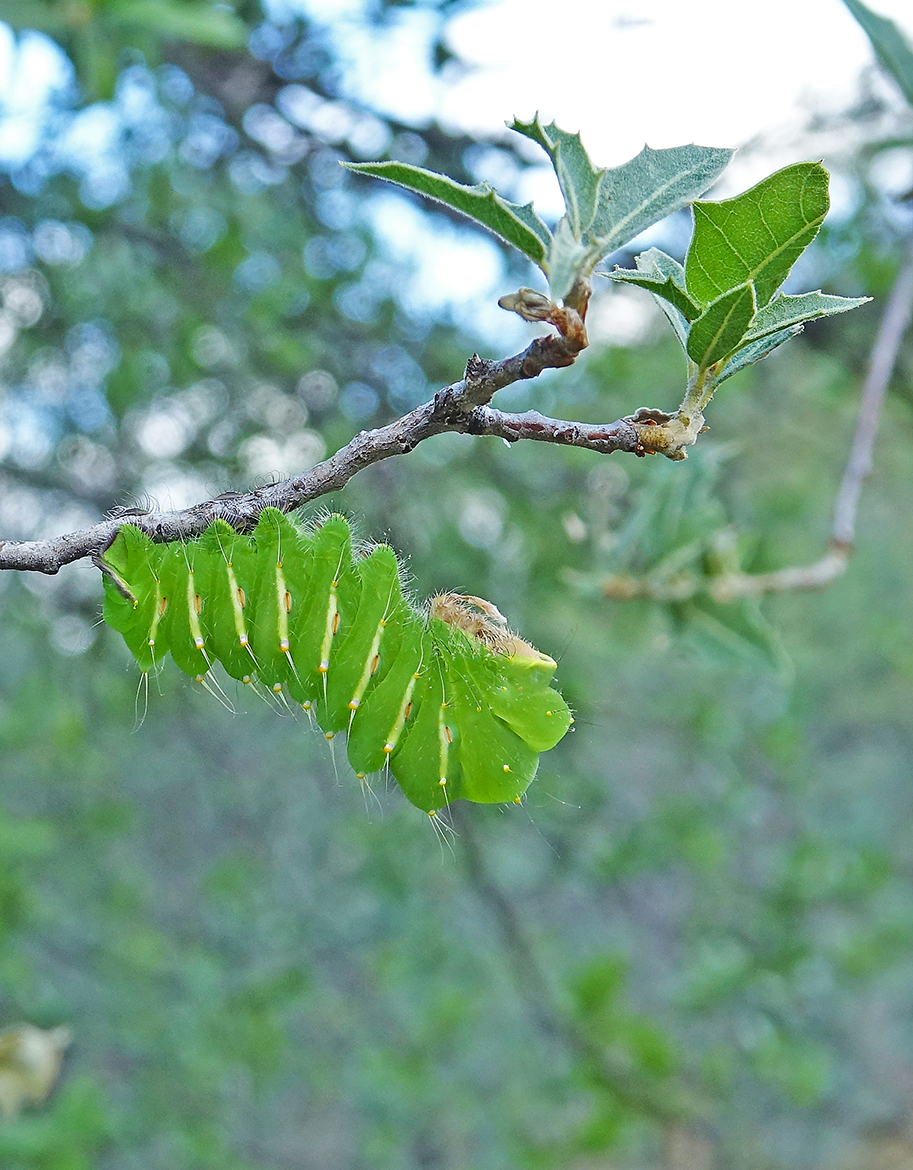
Western Prometheus Moth caterpillar resting on Emory Oak
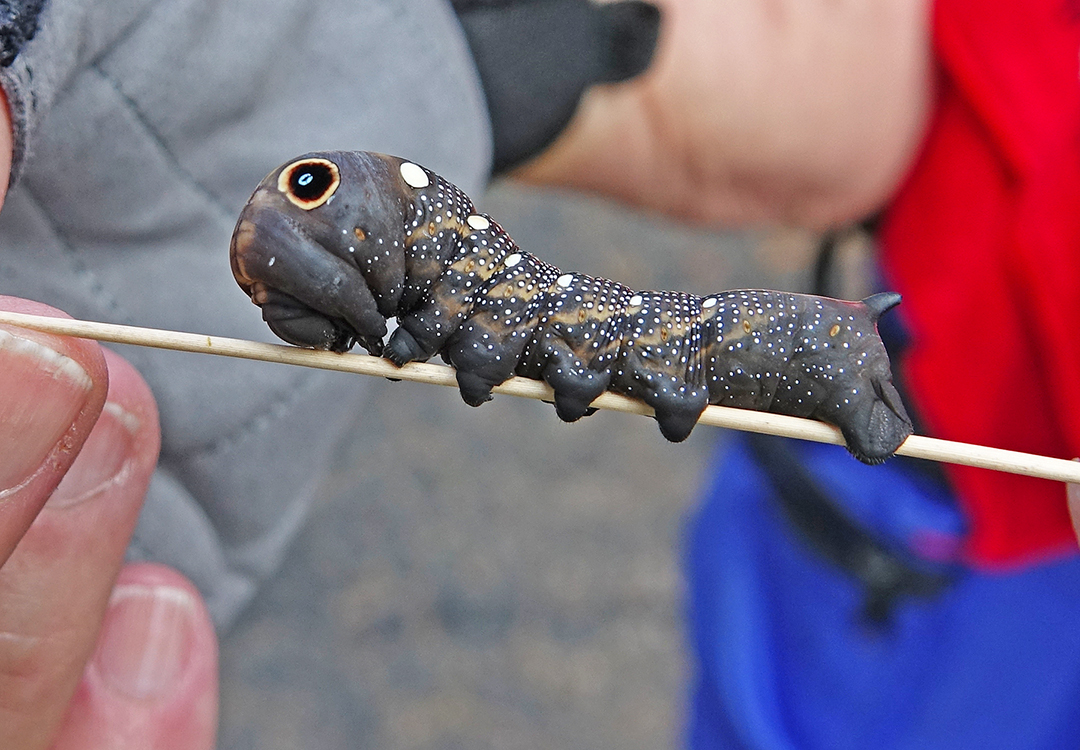
Falcon Sphinx Moth caterpillar, probably parasitized, on dry grass stem
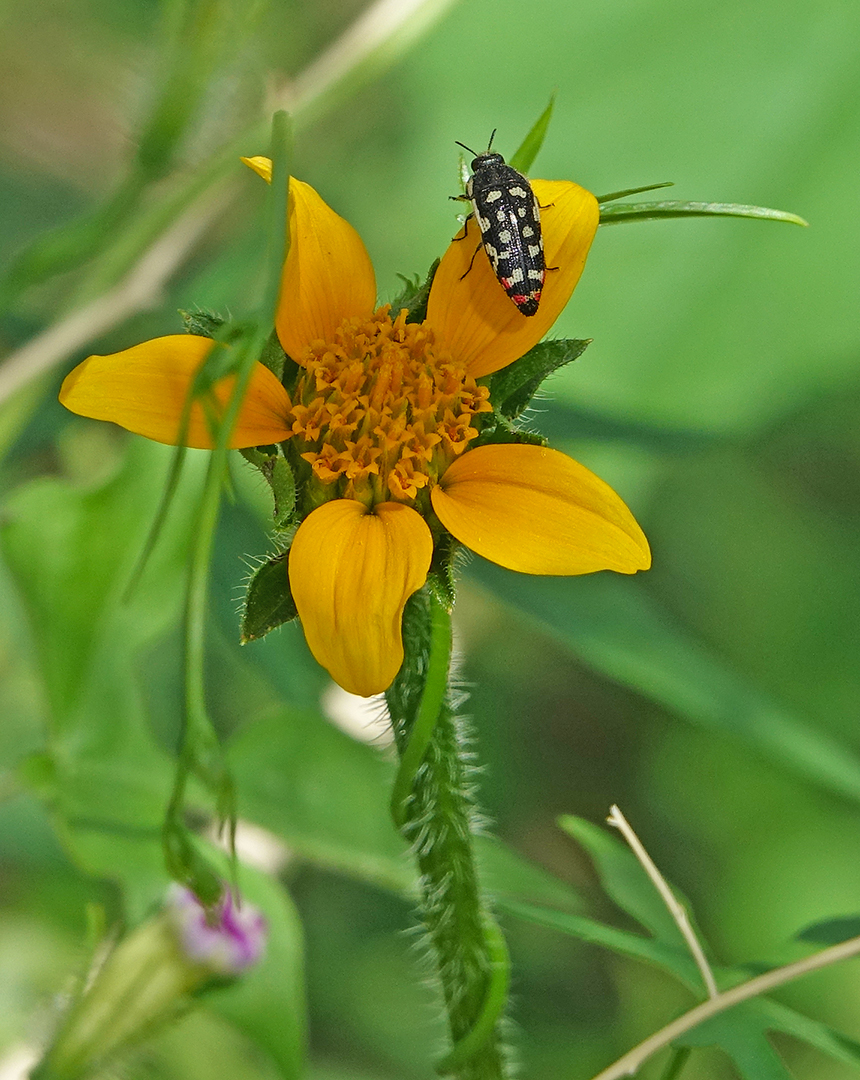
Acmaeodera Jewel Beetle on a Thurber’s Tithonia
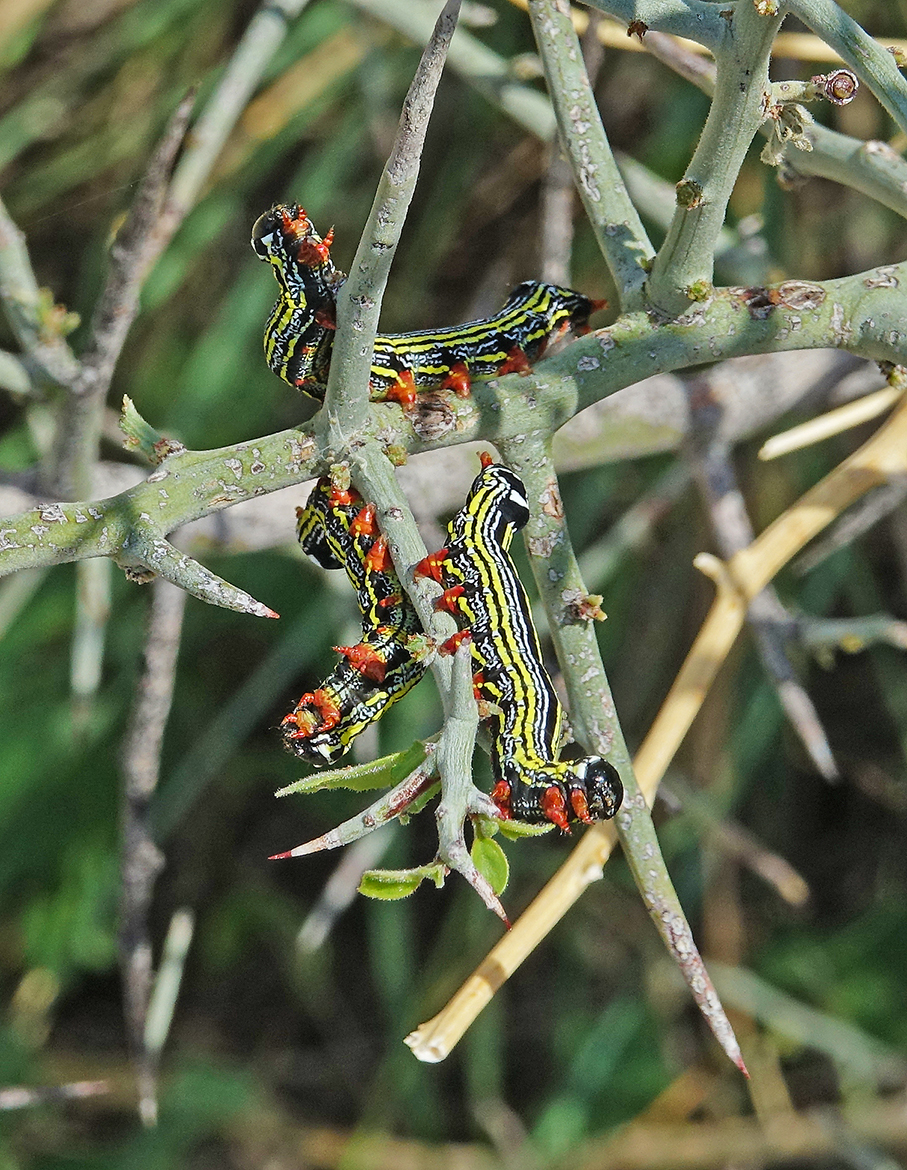
Three Cargida pyrrha moth caterpillars on a Graythorn bush
What a Difference Rain Makes!
By Judy White
If you walked through Madera Canyon in July and August 2025, you’ll have noticed that things were distinctly tan. Many plants lay dormant, waiting for rain, and the insects that depend on them were absent, as well. The end of monsoon season finally brought that rain. Although the rains were late this year, a great number of wildflowers rushed to grow and bloom, bringing lush green and lots of color to the Canyon. Below is a small sampling of what you might find in bloom in September and October.

Ivy Leaf Morning Glory, Ipomoea hederaceae

Arizona Sunflower Weed with Cane Cholla, Tithonia thurberi, and Cylindropuntia imbricata

Sweet Four O’Clock, Mirabilis longiflora

Yellow Thimblehead, Hymenothrix wislizenii

Bushy Tick Clover, Desmodium graham

Sacred Datura, Datyra wrightii

Isolated Blazingstar, Mentzelia isolate

Scarlet Betony, Stachys coccinea

Smooth Bouvardia, Bouvardia ternifolia

San Pedro Daisy, Lasianthaea podocephala
Where Are The Bugs?
If you visit Madera Canyon in a really dry spring such as the one in 2025, you’d likely notice the absence of insects. You might wonder, where are they? Like all of us, they and their offspring have to eat and need water to survive. That means sufficient rain – to encourage the growth of food plants; to make the soil moist enough for overwintering larvae or nymphs to emerge as adults; and to provide pools and flowing water for needed habitat. The winter of 2024-25 was one of the driest on record, so guess how that answers the question, “where are all the bugs?” Insects have developed sensitivities to humidity and temperature that alert them to when the weather patterns are producing the right conditions that will sustain them and their offspring. Some insects have the ability to remain dormant for a year or more, if conditions aren’t right to emerge, lay eggs and have food for their larvae.
Some insects are waiting underground for the right conditions to emerge. Grasshoppers, for example, spend the winter as eggs in the soil. When it rains, and plants begin to grow, those eggs hatch into nymphs (which look like tiny grasshoppers without wings), and emerge to eat and eventually become adults.
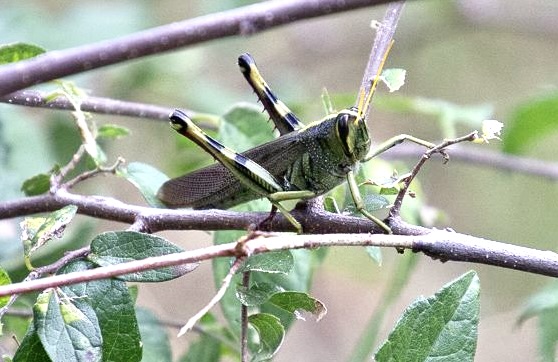
Grasshopper. J. Burkstrand
Others may be over-wintering in the dead wood of trees. Longhorn beetle grubs feed in the wood of living or dead trees or shrubs, awaiting warmer weather to emerge as adults. Look for groups of emergence holes of one of our largest longhorn beetles in dead portions of sycamore trees.
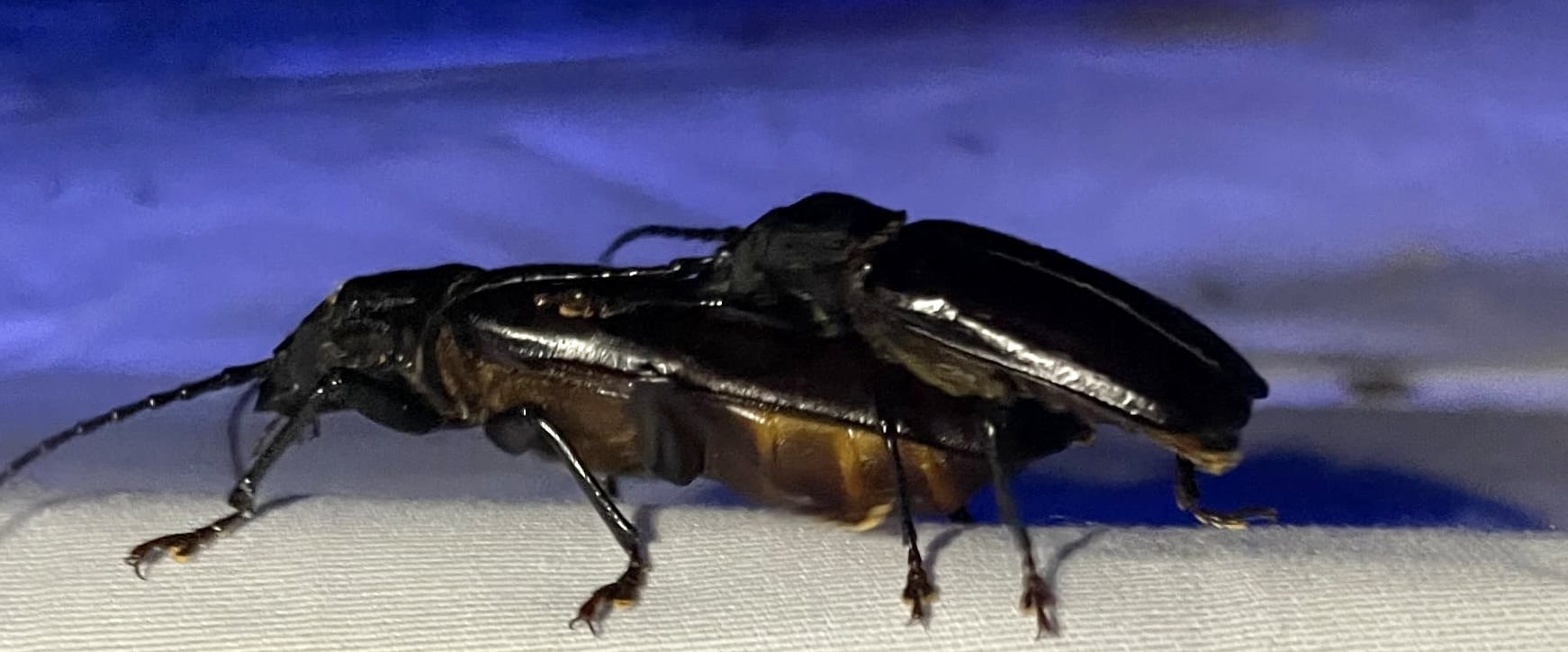
Longhorn beetle. S. Lingafelter
Eggs of some insects will be waiting attached to old plant stems or tree bark. Praying mantis egg cases can be easy to spot on stems of plants. When the rains come, the eggs inside the cases will hatch into tiny nymphs. To develop into adult mantises, they will feed on tiny insects that also will have emerged because of the rain and plant growth.
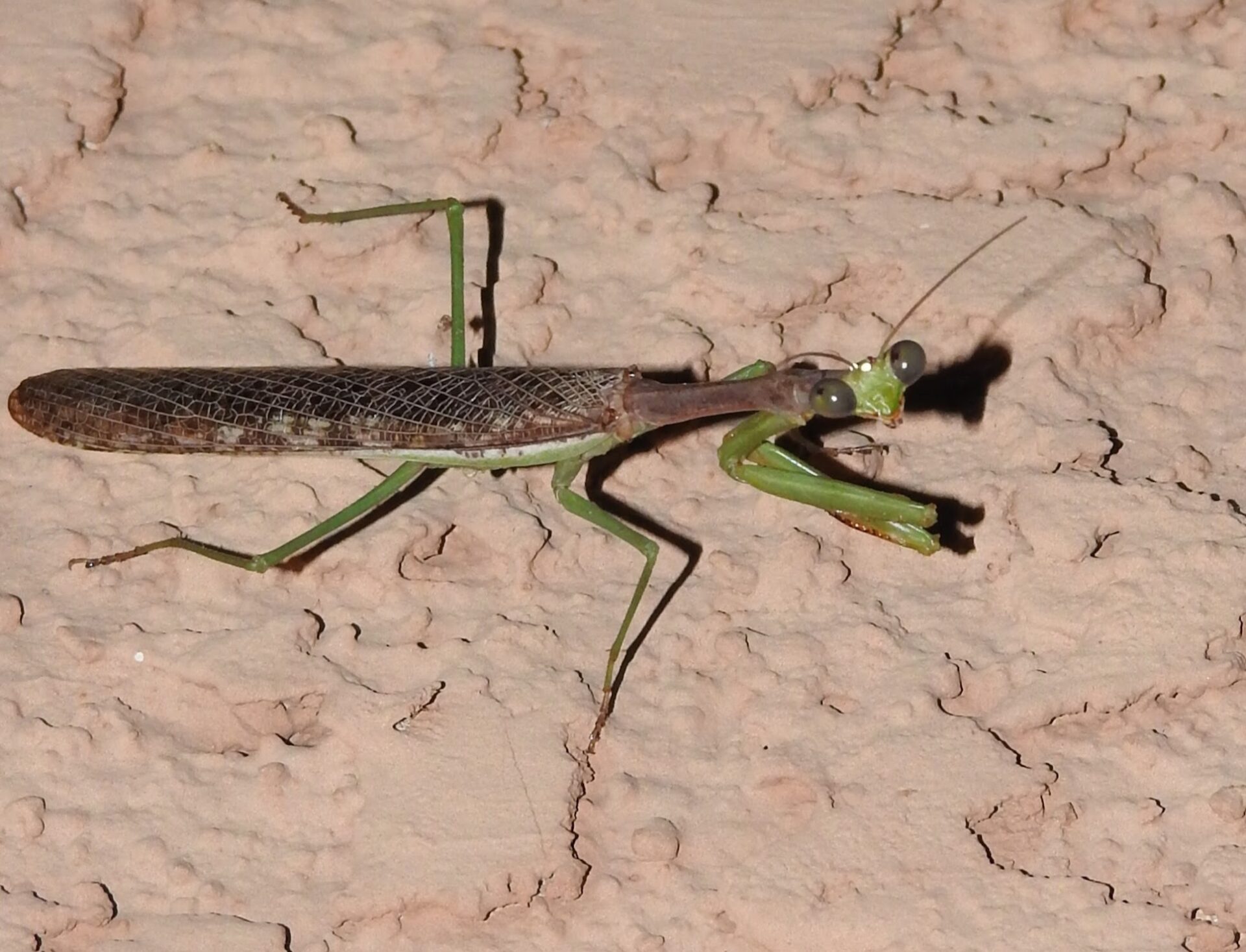
Praying Mantis E. Freedman
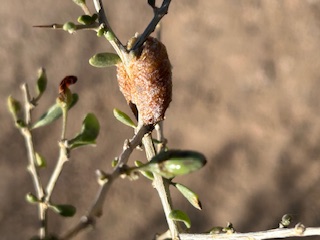
Egg Case E. Freedman
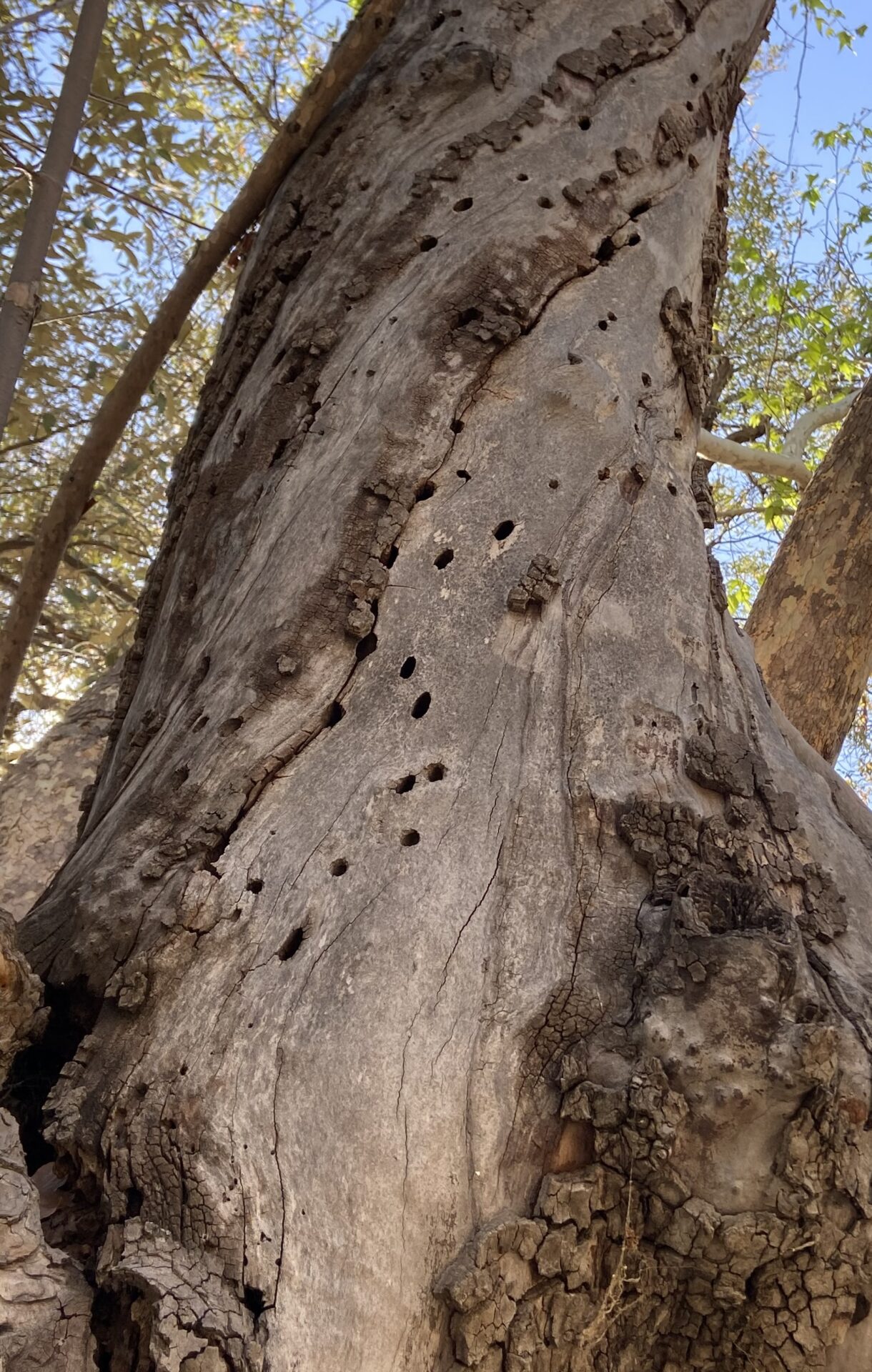
Longhorn beetle Emergence Holes
J. White
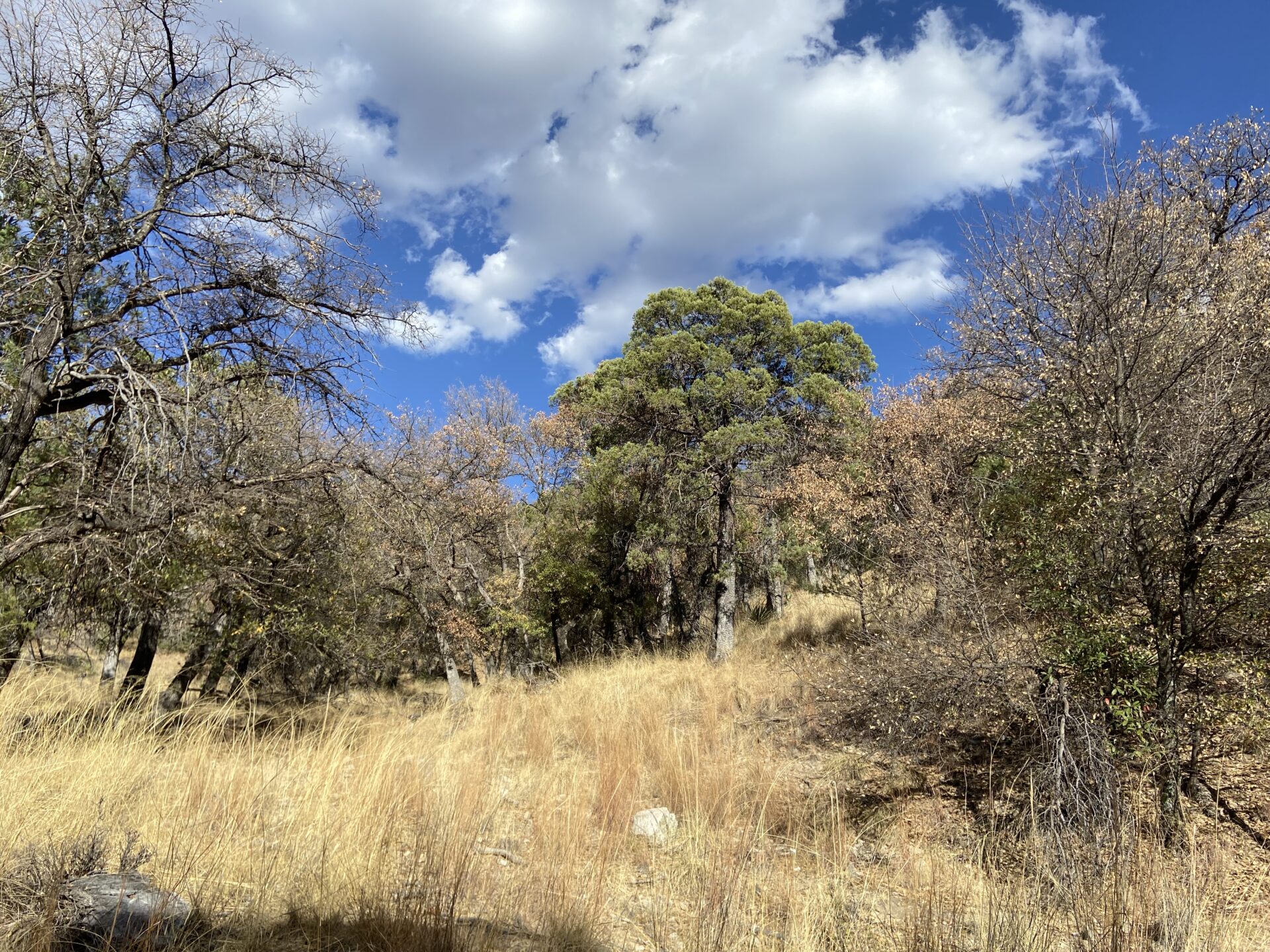
Oaks under stress. J. White
Oak trees are a noticeable indication of conditions in Madera Canyon. Trees that grow in riparian areas, (such as sycamores and cottonwoods) may still be leafing out with spring green leaves in spite of dry conditions, because their roots are deep and in areas where groundwater is more available. Oaks, however, are not so lucky. When the live oak leaves begin to turn brown, that is a signal that they are under great stress from lack of water.
Many butterflies and moths depend on the oaksfor sustenance. Their caterpillars feed only on new oak growth. If the moths hatch in the warming weather, and lay eggs but there are no new oak leaves for their caterpillars to eat, you can guess what happens.
Though it will be a shortened season for reproduction, a good monsoon season can help to bring out some of the insects not seen in the canyon during a dry spring. When there is sufficient rain, look for these and other insects in Madera Canyon.
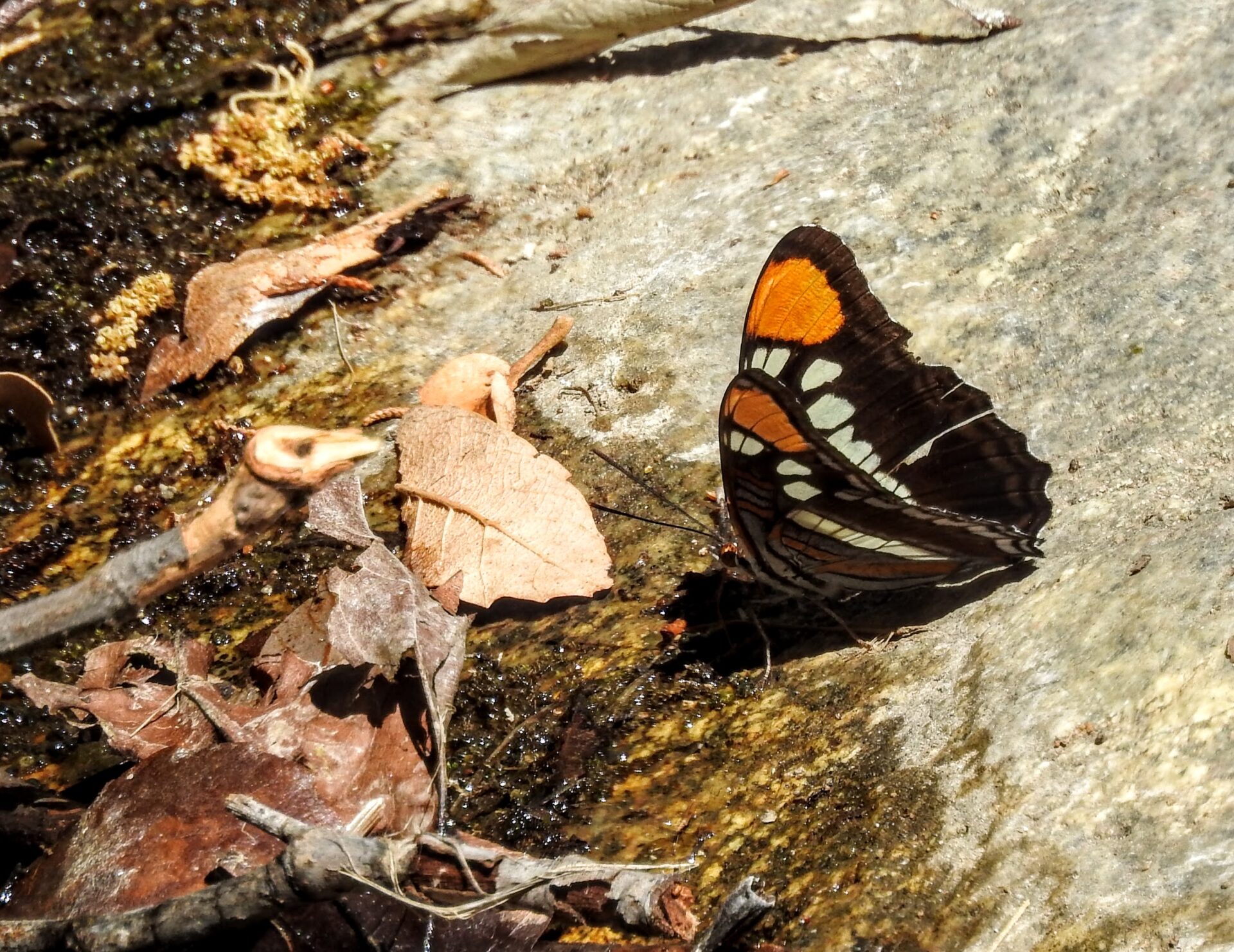
Sister Butterfly sipping water. E. Freedman
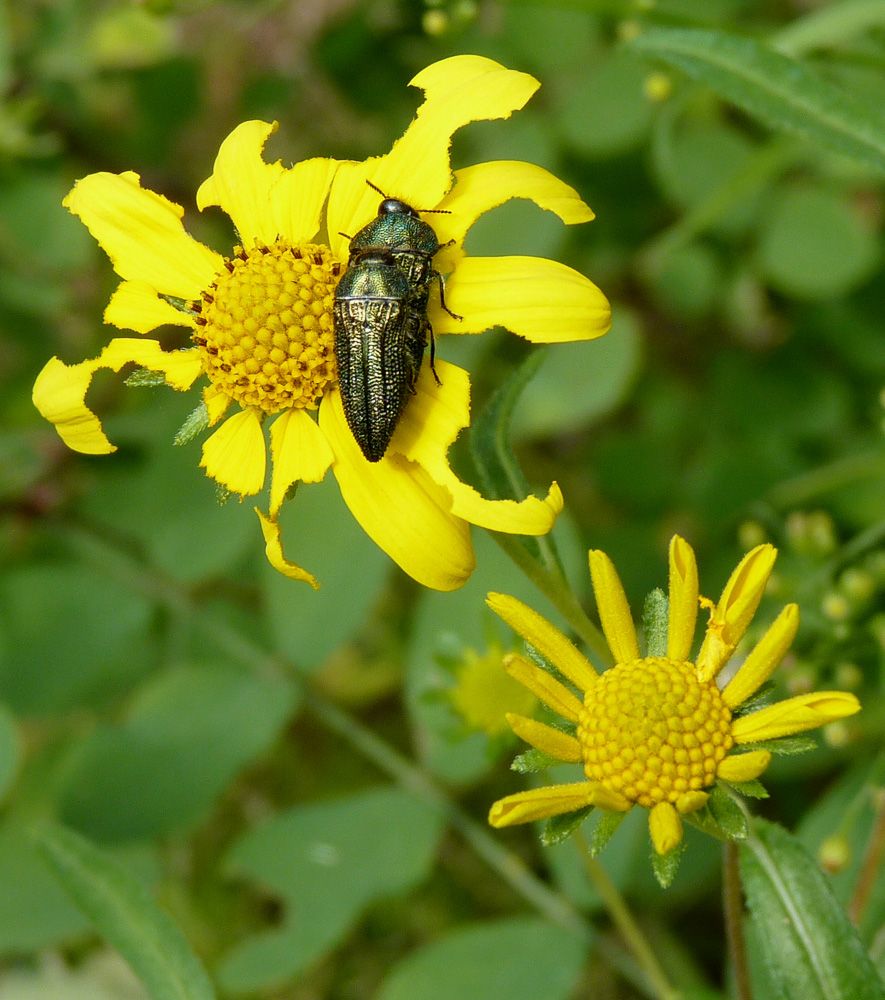
Acmaeodera Resplendens Jewel Beetle.
D. Moore
Madera Canyon Faces Harsh Reality of Spring Drought
By Jim Burkstrand
For the past two months, as an Education docent for the Friends of Madera Canyon, I observed firsthand the stark effects of an unrelenting dry spell on this normally vibrant ecosystem while leading groups of students. Our purpose has been to explore the canyon’s natural rhythms—birdsong, blossoms, the quiet movement of insects among leaves. But this year, the rhythms are off.
It has been a dry spring in Southern Arizona, and life in the canyon is showing the strain. The scarcity of insects and other small creatures has been a persistent challenge, a clear indicator of the parched conditions gripping the area.
On Thursday, April 25th, a visit to the canyon provided an opportunity to document the visible impacts of the drought on the landscape. The warm day presented clear skies and calm winds, seemingly ideal for observation.
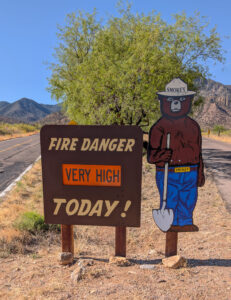 The immediate indication of the severity of the situation was evident upon entering the Proctor parking lot: a “Very High” fire danger warning was prominently displayed. This is the equivalent of a local red flag warning, signaling heightened fire risk. It is a stark reminder of how brittle the landscape has become.
The immediate indication of the severity of the situation was evident upon entering the Proctor parking lot: a “Very High” fire danger warning was prominently displayed. This is the equivalent of a local red flag warning, signaling heightened fire risk. It is a stark reminder of how brittle the landscape has become.
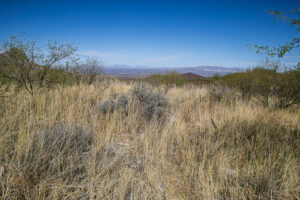 The initial walk along the Proctor Trail revealed a parched expanse of grasslands, underscoring the imminent threat of fire. The normally abundant wildflowers were notably absent, scattered sparsely across the dry terrain. The students never did see any of the usual Mexican gold poppies. Honeysuckles, typically a hallmark of the canyon’s springtime splendor, were difficult to locate.
The initial walk along the Proctor Trail revealed a parched expanse of grasslands, underscoring the imminent threat of fire. The normally abundant wildflowers were notably absent, scattered sparsely across the dry terrain. The students never did see any of the usual Mexican gold poppies. Honeysuckles, typically a hallmark of the canyon’s springtime splendor, were difficult to locate.
Bird sightings were infrequent, though a Verdin was observed successfully foraging for a rare insect. The lack of insects likely contributes to the diminished bird population within the canyon, as they are forced to seek food elsewhere.
Madera Creek remains dry. Crossing Proctor Road led into the Oak & Juniper Woodland, where the effects of the drought were equally apparent. A venerable oak tree, estimated to be well over a century old and already mature during the White House era, exhibited widespread browning of its leaves.
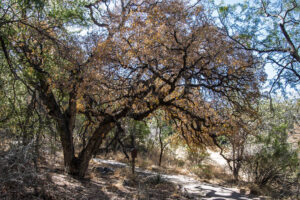
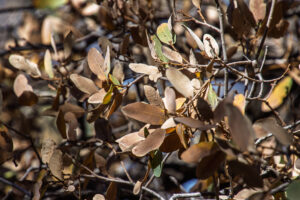
This phenomenon is reminiscent of a two-year drought experienced in recent years. The continued dry conditions suggest that the oak is likely to shed most of its leaves by late June or early July, a condition that will persist until significant monsoon rain arrives.
Still, life persists. White-tailed deer were seen foraging quietly along the trail, and a Carpenter Bee, absent in recent weeks, made an appearance. Mexican Blue Jays, more often seen at higher altitudes were foraging for food. A female Black Beaded Grosbeak, just arriving for the summer, was also spotted and photographed. An Acorn Woodpecker also made its presence known, hammering at a distant tree.
While Madera Canyon remains a worthwhile destination for a walk or hike, visitors should temper their expectations. The canyon, usually vibrant with color and sound this time of year, is subdued—waiting, like the rest of us, for rain.
Exploring Nature
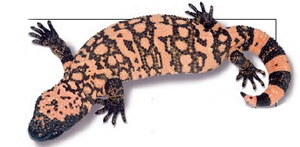
Venomous Reptiles
The Gila Monster is a venomous lizard that rarely bites humans unless handled.
READ MORE VENOMOUS REPTILES
An encounter with a rattlesnake is a potentially dangerous situation; your knowledge about reptiles and how to avoid rattlesnakes could be invaluable. If you live on the outer edges of town or in the desert, the chances of encountering a snake are high. Most reptiles are harmless. Of the venomous reptiles of our region, only the rattlesnake is truly a safety concern around your home. The Sonoran Coral snake is a small, shy snake usually less than 17 inches in length and not much bigger around than a pencil, – much smaller than the dangerous Coral snakes of the southeastern US and tropical Mexico. Though venomous, the Sonoran Coral snake has a very small head and mouth and is only prone to bite when handled. Most other snakes and lizards are also likely to bite in defense if handled but are considered nonvenomous and therefore harmless to humans. Wild animals should never be handled; it puts the handler at risk and is extremely stressful to the animal.
This informative article with crucial information and excellent photos Living with Venomous Reptiles (PDF) is provided by The Tucson Herpetological Society.
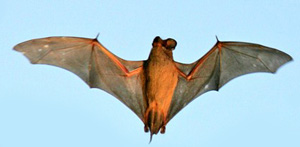
Bats
Despite extensive public education, misconceptions about bats persist and bats remain targets of human suspicion, superstition, and fear.
READ MORE BATS
Friends of Madera Canyon has initiated the Bat House Project to promote bat awareness and conservation, provide additional bat roosting space and to raise public understanding of the vital role bats play in southern Arizona’s ecosystems.
Bats are the only mammals capable of true flight. Nocturnal, they sleep during the day in protected places and emerge at night to hunt for food. Though most bats have excellent vision and a well-developed sense of smell, they rely primarily on sonar or “echo-location” to find food and avoid flying into objects. Nearly 1000 bat species worldwide, there are 35 species in the USA, and seventeen species identified in Madera Canyon and Santa Rita Mountains, including the only Arizona record of Ghost-faced Bat. Some live in the canyon year-round, others are “snowbirds,” residing here part time and migrating away seasonally.
Southern Arizona bats utilize different habitats. California Leaf-nosed Bats live in the desert, Silver-haired Bat are only found high up in Sky Island mountain forests. Big Brown Bats are habitat generalists and utilize a variety of habitats. Mexican Free-tailed Bat and Pallid Bat are the most common species in the southwest. Bat sizes vary, Mexican Free-tailed Bats have a 12″ wingspan and weigh as much as 4 pennies (4/10 oz.). The smallest bat in Arizona, the Western Pipistrelle, has an 8″ wingspan and weighs 1/10 oz. (1 penny!).
The majority of our local bat species feed solely on insects and an individual is can catch more than 500 insects per hour! Mexican Free-tailed Bats from three caves near San Antonio, TX, consume up to a million pounds of insects a night! Such statistics illustrate the importance of bats in controlling insect pests, such as mosquitoes. Two migrating local species, the Long-nosed Bat and Long-tongued Bat, are pollinators that feed on nectar and pollen of saguaro, ocotillo, and agave blossoms – and famous for draining hummingbird feeders at night. Pallid Bats often hunt on the ground, crawling and hopping about on the elbows of their folded wings to catch spiders, scorpions, and centipedes!
Over several decades, bat populations have declined in the U.S. due to pesticide use, habitat loss and unjustified persecution. Our bat houses at 5 sites in the canyon, and at La Posada and Continental School. were built by Al Tozier, Bud Gode, Luis Calvo and U.S. Forest Service Ranger Don Marion.
Results? For a time, direct observations and accumulations of guano beneath indicated bats were using the two small, compact house designs, but not the larger, flat rectangular houses. Analysis of temperature data corroborated these observations. Data showed that large houses, with their direct, west-sun orientation, were often too hot for bats during spring and summer when they are most likely to be in Madera Canyon. This design, with a tendency to blow over in high winds, was replaced with smaller, cooler, improved ventilation models. A new adjustable mount allowed for precise sun orientation.
Remarkable animals, well-adapted to live in our Sky Island habitats are seen at evening picnics in Madera Canyon. Contact Doug Moore for more info at: info@friendsofmaderacanyon.org.
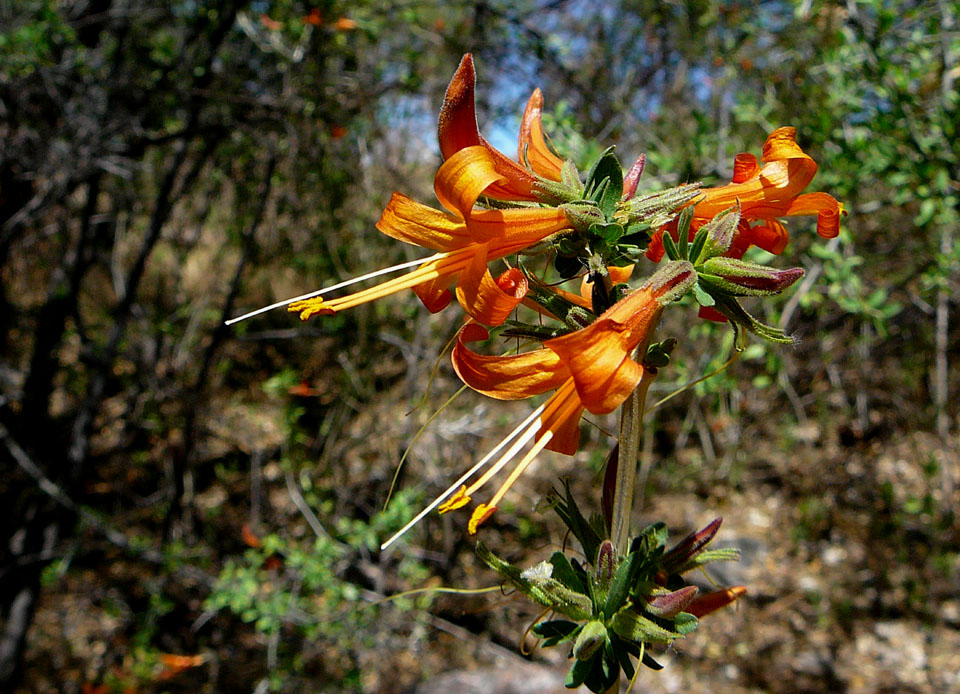
2024 Spring Wildflowers
Doug Moore
Last month, with the first hints of spring coming to southeastern Arizona, I made some hopeful predictions for a good spring wildflower bloom in the canyon. After timely late fall and winter precipitation, all indications were good. Now in late March- following warming daytime temps and even more rain- I’m happy to report that many flowers are indeed blooming!
As of March 26, the lower canyon above Proctor is becoming verdant. The cottonwoods along the creek are fully leafed-out, while mesquites & sycamores are just now popping new leaves. The lush green carpet of “fuzz” spreading profusely over the ground as perennials & annuals sprouted, has matured into the blooming rosettes of Mexican Gold Poppy, Blue Phacelia, Desert Anemone, Nevada Biscuit Root, Desert Hyacinth, Golden Smoke, and a variety of wild mustards. Silver Puff- our tiny-flowered version of yellow dandelions- is also common this year. The brilliant poppy show around the Proctor Ramada is especially pretty.
Native understory shrubs will be producing a show soon also. Arizona Desert Thorn, a wolfberry, is full of tiny pink bell flowers and globemallow shrubs are budded up with the few first orange blossoms showing. Fairy Duster around the parking area is leafing out; their pink pompom flower clusters will follow close behind. Desert Honeysuckle is in leaf all along the trail in the mesquite bosque & on the left trail above the split. A banner season for their orange trumpet flowers appears imminent- happy days for hummingbirds and insect pollinators!
As noted last month, as we move on through spring, different trees, shrubs, perennials and annuals will flower. The bloom will gradually move up into higher elevations in the canyon. I’m scanning the trail between Proctor and White House for stalks of deep-pink Perry’s Penstemon and magenta Ribbon Four O’clock. I’ll also be watching for scarlet Claret Cup Hedgehog cactus flowers on the cliffside above the White House Bridge, and waiting for the scarlet trumpets of Smooth Bouvardia shrubs to bloom below the Claret Cups along the burbling creek.
Happy spring and good wildflower hunting!
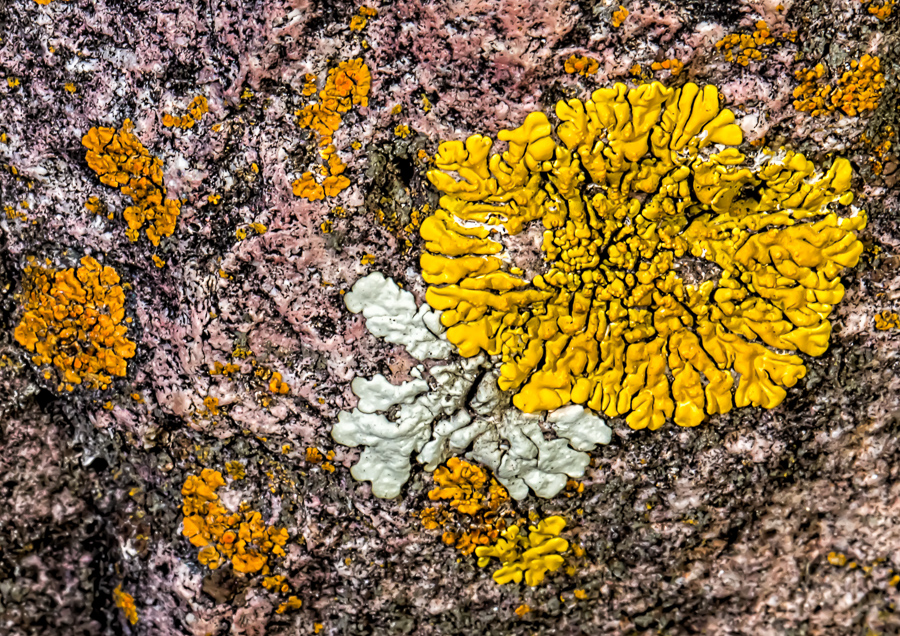
LICHENS
By Penny France
Freddy fungus and Alice algae
took a lichen to each other, but
their marriage was on the rocks.
You have probably seen the green, crusty lichens living on the surface of rocks in Madera Canyon and walked right on by. These initially-unappealing lichens are more interesting than you could ever imagine. Since this year seems to be is an especially good year for seeing healthy specimens, now is a perfect time to learn more about them.
It is estimated that about 8% of the earth’s surface is covered by lichens and that there are at least 3,600 varieties of lichen just in North America. Lichens constitute the sole vegetation of extreme environments such as the Arctic tundra. They can live in hot dry deserts, and in coastal habitats where fog and water vapor abound. Lichens are successful in colonizing on rocks, on or inside the bark of woody plants, on wood, soil, mosses, leaves of vascular plants (especially in the tropics), and even on other lichens, as well as on man-made substrates such as concrete, glass, metals and plastics and slag heaps. Further, they are considered to be among the oldest living organism. An arctic species, has been dated as being about 8600 years old
Just what is a lichen? Notice that we haven’t called it a plant; it’s not a plant. The lichen does not have vascular tissue like a plant’s xylem and phloem to move nutrients and water around nor does it have the waxy cuticle like leaves on plants have. The unique characteristic of a lichen is that its life depends on a combination of two organisms—the fungus and the alga. The more numerous fungi cannot produce food but can provide moisture, fight off disease and provide growth functions. Fungi are known for their role in decomposition of organic matter. The alga partner photosynthesizes and provides food for the fungus so it can grow and spread. They rely on each other to provide life. It’s called a symbiotic relationship. There are over13,500 kinds of fungi species in the world. The name of the fungal species prevalent in a lichen serves as the name given that lichen.
Read More
The lichen’s general structure is composed of layers of fungus threads and green and/or blue-green cyanobacteria alga that together form the interior of the thallus. The thallus is so integrated into the fungus/alga mix that only recently has it it been studied as a single organism in the lichen. The thallus lies against the substrate and has no clearly-defined stems or leaves.
Lichens grow slowly, live a long time, are stress tolerant, and come in many colors and shapes (some even resemble minute forests). The outer layer inside the thallus is the cortex and provides a little protection and color, in some species. The algal layer usually tells us, by color, the kind of alga a lichen has. When dry, it is usually gray or matches the cortex color but, when wet, those cells become transparent and the algal cells underneath show their color. Cyanobacteria can be a layer under the upper cortex or in small pockets on top of the cortex. If there is a green algal layer already present, it will give the lichen a dark green, brown, or black color. In some lichens however, there are no layers of fungus and alga. The individual components are mixed together in one big uniform layer and the resulting growth form is gelatinous. These types are called jelly lichens—definitely qualifying as a unique shape.
How do lichens attach themselves to a substrate? There are a couple of ways. Rhizomes are fungal filaments that extend out and hold the lichen down to whatever it is sitting on—the substrate. The other way is the “holdfast,” an extension of the lichen thallus. Some lichens have a central peg or holdfast that attaches to the substrate—typically a rock—kind of like an umbilical cord.
About one billion people globally eat lichens as part of their diet. They are used to prepare indigenous foods, beverages, spices and animal feed in various cultures around the world.
Since the fungus can protect its algae, the normally water-requiring lichens can live in dry, sunny climates without dying as long as there are occasional rain showers or flooding to let them recharge and store food for the next drought period. Further, lichens provide a means to convert carbon dioxide in the atmosphere through photosynthesis into oxygen, which we all need to survive.
In recent years, lichens have become more frequent subjects for scientific research. Their unique symbiotic association between alga/cyanobacterium and a fungus produce secondary metabolites that offer promising drug leads. To quote an article in an August 2022 Journal of Ethnopharmacology entitled “Lichens: An Update on their Ethnopharmacological Uses and Potential as Sources of Drug Leads”: “Natural products are low molecular weight molecules produced by living organisms (plants, animals, and microbes) and have been traditional leads for medicines for ages. They have a historic significance as important novel compounds which are useful as drugs, models for synthetic/semisynthetic structure modifications and optimization, biochemical and pharmacological probes…”. “Natural product molecules and/or their synthetic modifications, have been particularly useful for chemotherapy of cancer and malaria.” “…introduction of new therapeutic agents has not kept pace with the increase in the evolution of multi-drug resistant microbial strains, making many infections untreatable. There is therefore a dire need for novel drugs.”
So that ho-hum lichen we routinely walk by without noticing has something pretty special about it that is well-worth our attention and appreciation.
Photos by Jim Burkstrand
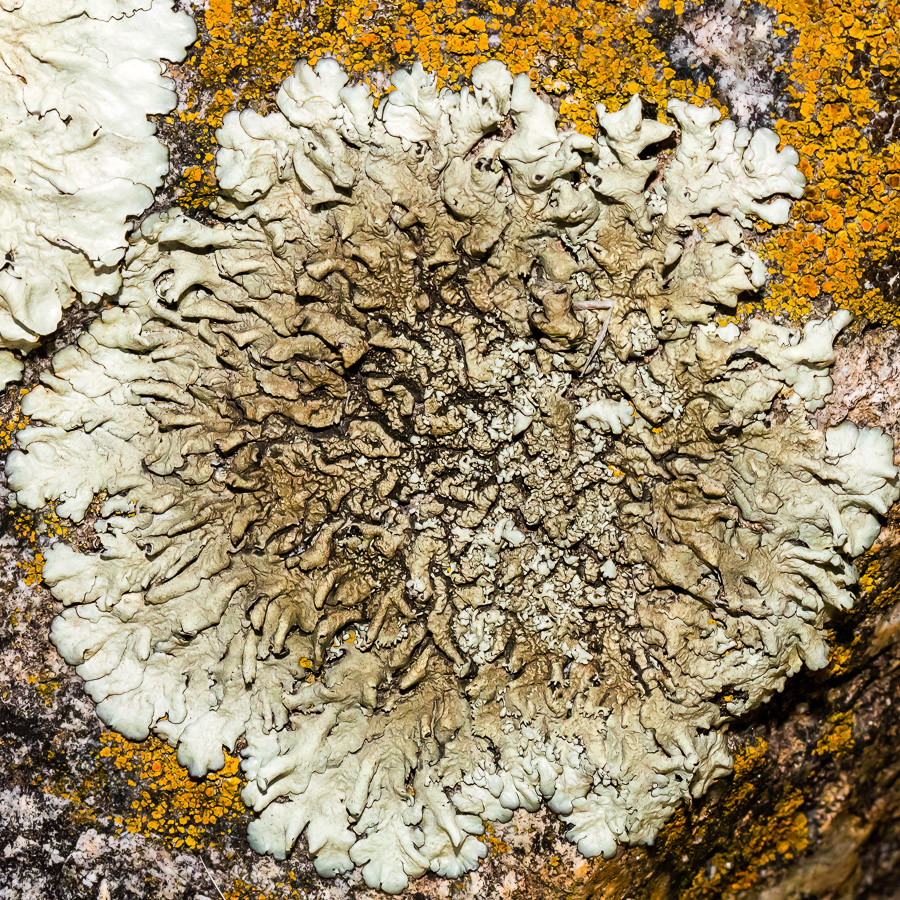

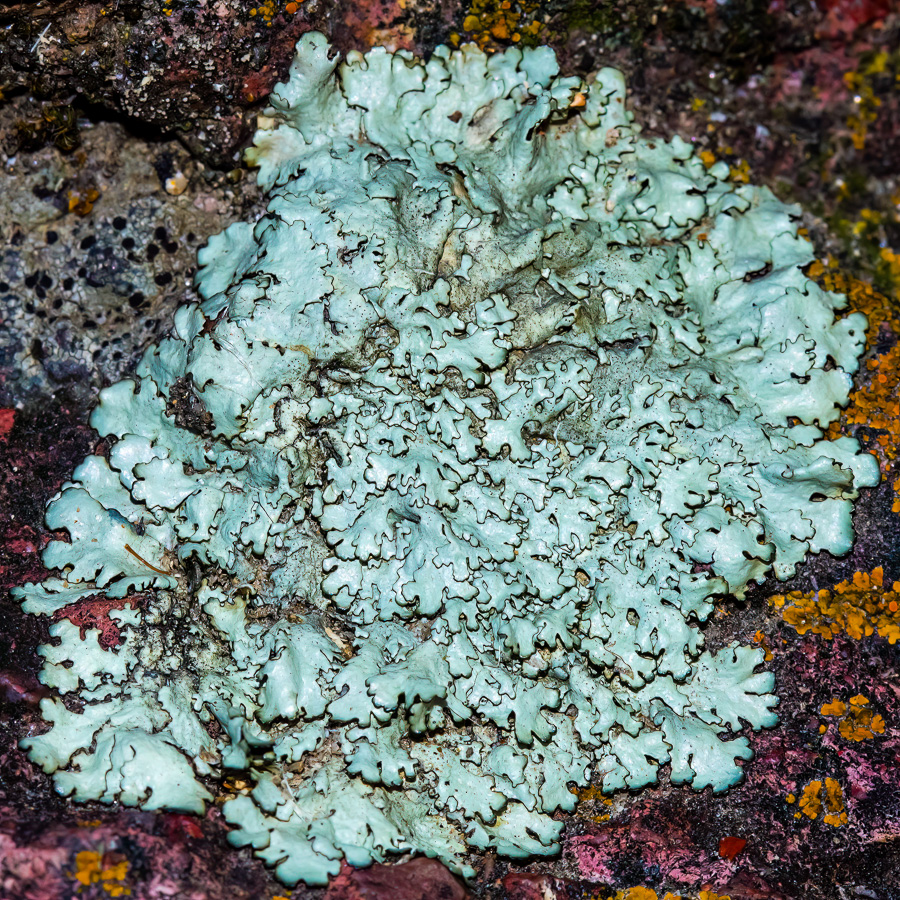
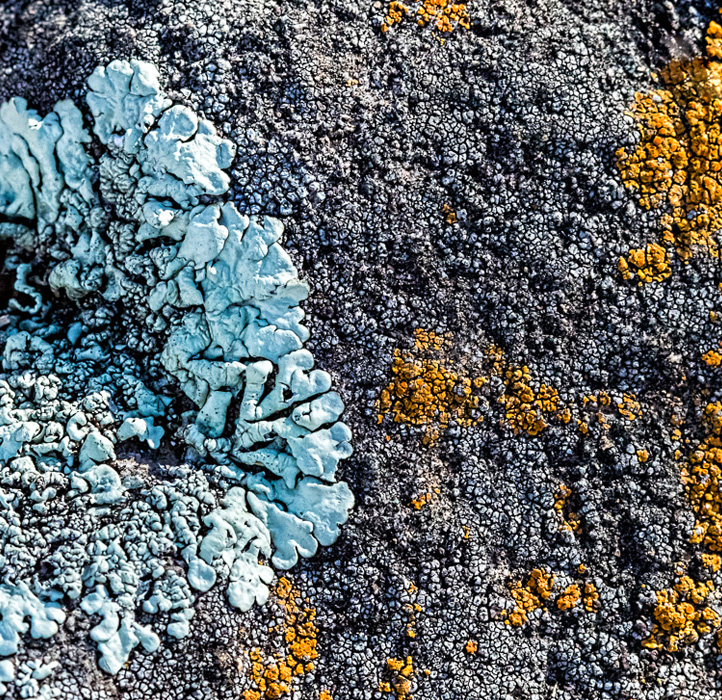
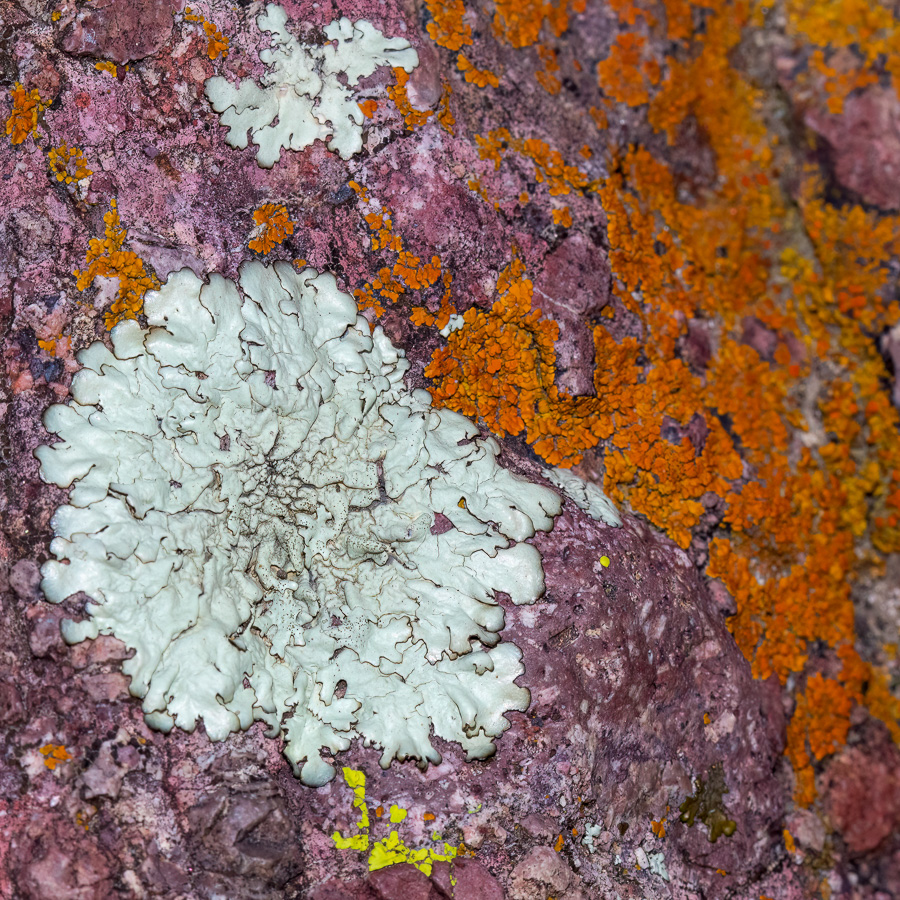

A New Moth with a Type Locality in Madera Canyon
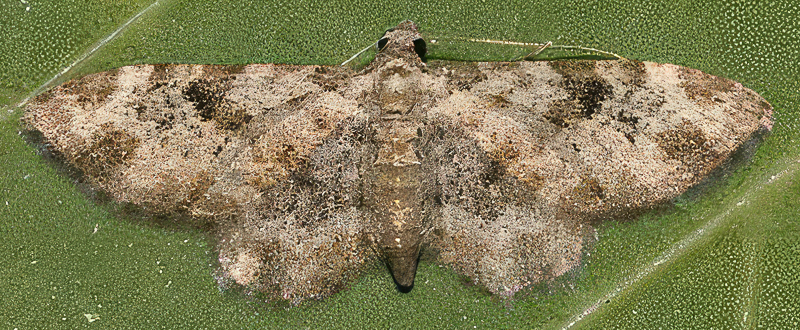
A new geometrid moth Eupithecia neremorata (Ferris & Russo, 2023), with a type locality in Madera Canyon.
Photography by Charles Melton
By John Murphy
More than 100 species have been described with type specimens from Madera Canyon. The most recent is the geometrid moth Prorella neremorata described by Ferris and Russo in late 2023. By the time the new description was published the higher level classification had been revised and its name changed to Eupithecia neremorata (Ferris & Russo, 2023) by Schmidt & McGuinness (in Pohl & Nanz (eds.) 2023). Eupithecia neremorata is a member of the remorata group.
References
- Ferris, C.D. & J. Russo, 2023. Review of the Prorella remorata Group with Description of a New Species from Arizona (Geometridae: Larentiinae: Eupitheciini). Journal of the Lepidopterists’ Society, 77(4): 226-234.
- Pohl, G. R. and S. R. Nanz (eds.). 2023. Annotated Taxonomic Checklist of the Lepidoptera of North America, North of Mexico. Wedge Entomological Research Foundation, Bakersfield, California, xiv + 580 pp.
Trogonids in Arizona, How far do I have to walk?
Other Reading on Nature:
News from the US Forest Service (USFS)
The USFS wants to share that the USFS Madera Canyon Recreation Guide is now available online in English and Spanish.
You can navigate to them (and the other guides that have been developed) on the website by selecting Visit Us > Maps & Publications and then scrolling down to "Recreation Guides."
 The USFS also created a new landing page for Madera Canyon on the Forest's website. You can find it here.
The USFS also created a new landing page for Madera Canyon on the Forest's website. You can find it here.
You can navigate to it on the website by selecting Visit Us > Destinations > Madera Canyon

